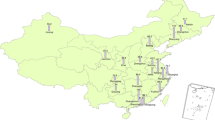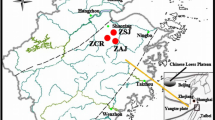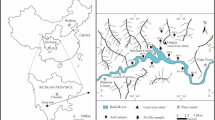Abstract
Atmospheric lead (Pb) and other trace metals can transport over long distance and deposit on remote alpine ecosystems. In this work, the soil profiles, litter and dominant mosses along a large altitude were collected on Ao Mountain, Central China, to obtain the spatial distributions of Pb in these materials, decipher the possible factors controlling the distribution, and quantitatively distinguish the natural versus anthropogenic sources of Pb through the Pb isotopic tracing and biomonitoring. The results show that soil Pb concentrations (mg/kg) decreased significantly with depth, and they were markedly higher in the O (42.6 ± 2.7) and A (36.4 ± 2.2) horizons than in the litter (7.20 ± 1.9) and mosses (28.0 ± 3.9). The Pb enrichment in the surface soils (O and A horizons), litter and mosses existed in the relatively high altitudes, which was attributed to the influences from atmospheric wet deposition, plants, soil physicochemical properties and human activity. The Pb isotopic ratios identified the Pb sources as originating mainly from Chinese coal combustion, mining and smelting. Atmospheric Pb from southeastern, southwestern and northwestern regions could be deposited in the alpine ecosystem by long distance atmospheric transport. The anthropogenic Pb reached over 50% in the O and A horizons, and over 70% in the litter and mosses, which corresponded to the concentrations of 26.9, 17.7, 5.92 and 21.2 mg/kg, respectively. The results indicate that the mutual effects of climate and regional human activity could increase the Pb accumulation in remote alpine ecosystems.
Similar content being viewed by others
Change history
22 June 2018
An Erratum to this paper has been published: https://doi.org/10.1007/s11629-018-4836-2
References
Bacon JR, Hewitt IJ (2005) Heavy metals deposited from the atmosphere on upland Scottish soils: Chemical and lead isotope studies of the association of metals with soil components. Geochimica et Cosmochimica Acta 69(1): 19–33. DOI: 10.1016/j.gca.2004.06.030
Barandovski L, Frontasyeva MV, Stafilov T, et al. (2012) Trends of atmospheric deposition of trace elements in Macedonia studied by the moss biomonitoring technique. Journal of Environmental Science and Health, Part A 47(13): 2000–2015. DOI: 10.1080/10934529.2012.695267
Bekteshi L, Lazo P, Qarri F, et al. (2015) Application of the normalization process in the survey of atmospheric deposition of heavy metals in Albania through moss biomonitoring. Ecological Indicators 56: 50–59. DOI: 10.1016/j.ecolind. 2015.03.001
Berg T, Steinnes E (1997) Use of mosses (Hylocomium splendens and Pleurozium schreberi) as biomonitors of heavy metal deposition: From relative to absolute deposition values. Environmental Pollution 98(1): 61–71. DOI: 10.1016/S0269-7491(97)00103-6
Bernal MP, McGrath SP (1994) Effects of pH and heavy metal concentrations in solution culture on the proton release, growth and elemental composition of Alyssum murale and Raphanus sativus L. Plant and Soil 166(1): 83–92. DOI: 10.1007/BF02185484
Bi XY, Feng XB, Yang YG, et al. (2007) Heavy metals in an impacted wetland system: a typical case from southwestern China. Science of the Total Environment 387(1): 257–268. DOI: 10.1016/j.scitotenv.2007.07.059
Bindler R, Brannvall ML, Renberg I (1999) Natural lead concentrations in pristine boreal forest soils and past pollution trends: A reference for critical load models. Environmental Science & Technology 33(19): 3362–3367. DOI: 10.1021/es9809307
Bing HJ, Wu YH, Zhou J, et al. (2016a) Vegetation and cold trapping modulating elevation-dependent distribution of trace metals in soils of a high mountain in Eastern Tibetan Plateau. Scientific Reports 6: 24081. DOI: 10.1038/srep24081
Bing HJ, Wu YH, Zhou J, et al. (2016b) Historical trends of anthropogenic metals in Eastern Tibetan Plateau as reconstructed from alpine lake sediments over the last century. Chemosphere 148: 211–219. DOI: 10.1016/j.chemos phere.2016.01.042
Bing HJ, Zhou J, Wu YH, et al. (2016c) Current state, sources, and potential risk of heavy metals in sediments of Three Gorges Reservoir, China. Environmental Pollution 214: 485–496. DOI: 10.1016/j.envpol.2016.04.062
Bing HJ, Wu YH, Zhou J, et al. (2014) Atmospheric deposition of lead in remote high mountain of eastern Tibetan Plateau, China. Atmospheric Environment 99: 425–435. DOI: 10.1016/j.atmosenv.2014.10.014
Blaser P, Zimmermann S, Luster J, et al. (2000) Critical examination of trace element enrichments and depletions in soils: As, Cr, Cu, Ni, Pb, and Zn in Swiss forest soils. Science of the Total Environment 249(1): 257–280. DOI: 10.1016/S0048-9697(99)00522-7
Bollhöfer A, Rosman KJR (2001) Isotopic source signatures for atmospheric lead: The Northern Hemisphere. Geochimica et Cosmochimica Acta 65(11): 1727–1740. DOI: 10.1016/S0016-7037(00)00630-x
Brännvall ML, Bindler R, Emteryd O, et al. (2001) Vertical distribution of atmospheric pollution lead in Swedish boreal forest soils. Water, Air, & Soil Pollution 1(3-4): 357–370.
Chen B, Stein AF, Maldonado PG, et al. (2013) Size distribution and concentrations of heavy metals in atmospheric aerosols originating from industrial emissions as predicted by the HYSPLIT model. Atmospheric Environment 71: 234–244. DOI: 10.1016/j.atmosenv.2013.02.013
Chen JM, Tan MG, Li YL, et al. (2005) A lead isotope record of Shanghai atmospheric lead emissions in total suspended particles during the period of phasing out of leaded gasoline. Atmospheric Environment 39(7): 1245–1253. DOI: 10.1016/j.atmosenv.2004.10.041
Chen YJ, Sui YH, Pirajno F (2003) Exclusive evidences for CMF model and a case of orogenic silver deposits: Isotope geochemistry of the Tieluping sliver deposit, East Qinling orogen. Acta Petrologica Sinica 19: 551–568. (In Chinese)
Cheng H, Hu Y (2010) Lead (Pb) isotopic fingerprinting and its applications in lead pollution studies in China: A review. Environmental Pollution 158(5): 1134–1146. DOI: 10.1016/j. atmosenv.2004.10.041
Cheng HR, Zhang G, Jiang JX, et al. (2007) Organochlorine pesticides, polybrominated biphenyl ethers and lead isotopes during the spring time at the Waliguan Baseline Observatory, Northwest China: Implication for long-range atmospheric transport. Atmospheric Environment 41(22): 4734–4747. DOI: 10.1016/j.atmosenv.2007.03.023
Cong ZY, Kang SC, Luo CL, et al. (2011) Trace elements and lead isotopic composition of PM10 in Lhasa, Tibet. Atmospheric Environment 45(34): 6210–6215. DOI: 10.1016/j.atmosenv. 2011.07.060
Dawson JJ, Tetzlaff D, Carey AM, et al. (2009) Characterizing Pb mobilization from upland soils to streams using 206Pb/207Pb isotopic ratios. Environmental Science & Technology 44(1): 243–249. DOI: 10.1021/es902664d
Flegal AR, Gallona C, Gangulia PM, et al. (2013) All the lead in China. Critical Reviews in Environmental Science and Technology 43(17): 1869–1944. DOI: 10.1080/10643389.2012.671738
Fu ZG, Weng JC, Yan CH, et al. (2010) Isotope geochemical characteristics of the Lengshuibeigou lead-zinc-silver ore district in East Qinling. Geophysical & Geochemical Exploration 34: 34–39. (In Chinese)
Gao ZY, Yin G, Ni SJ, et al. (2004) Geochemical features of the urban environmental lead isotope in Chengdu City. Carsologica Sinica 23: 267–272. (In Chinese)
Gerdol R, Bragazza L (2006) Effects of altitude on element accumulation in alpine moss. Chemosphere 64(5): 810–816. DOI: 10.1016/j.chemosphere.2005.10.053
Guan SP, Li ZX (1999) Lead-sulfur isotope study of carbonatehosted lead-zinc deposits at the eastern margin of the Kangdian axis. Geology-geochemistry 27(4): 45–54. (In Chinese)
Han Y, Zhu XY, Wang JB, et al. (2014) Geochemical characteristics of the lead and sulfur isotope and geological significance in the Fankou lead -zinc deposit, Guangdong. Mineral Exploration 5: 267–274. (In Chinese)
Harmens H, Norris DA, Steinnes E, et al. (2010) Mosses as biomonitors of atmospheric heavy metal deposition: Spatial patterns and temporal trends in Europe. Environmental Pollution 158(10): 3144–56. DOI: 10.1016/j.envpol.2010.06.039
Hosono T, Alvarez K, Kuwae M (2016) Lead isotope ratios in six lake sediment cores from Japan Archipelago: Historical record of trans-boundary pollution sources. Science of The Total Environment 559: 24–37. DOI: 10.1016/j.scitotenv.2016.03.138
Hu XL, Yao SZ, He MC, et al. (2014) Sulfur and lead isotopic characteristics of Chalukou and Daheishan porphyry Mo deposits in northern segment of Da Hinggan Mountains. Mineral Deposits 33: 776–784. (In Chinese)
Huang DH, Nie FJ, Wang YC (1984) Lead isotope compositions of molybdenum deposits in East Qinling as applied to the problem of ore sources. Mineral Deposits 3: 20–28. (In Chinese)
Johnson RC (1990) The interception, throughfall and stemflow in a forest in highland Scotland and the comparison with other upland forests in the UK. Journal of Hydrology 118(1): 281–287. DOI: 10.1016/0022-1694(90)90263-W
Kaste JM, Friedland AJ, Stürup S (2003) Using stable and radioactive isotopes to trace atmospherically deposited Pb in montane forest soils. Environmental Science & Technology 37(16): 3560–3567. DOI: 10.1021/es026372k
Kim JE, Han YJ, Kim PR, et al. (2012) Factors influencing atmospheric wet deposition of trace elements in rural Korea. Atmospheric Research 116: 185–194. DOI: 10.1016/j.atmosres. 2012.04.013
Klaminder J, Bindler R, Emteryd O, et al. (2005) Uptake and recycling of lead by boreal forest plants: Quantitative estimates from a site in northern Sweden. Geochimica et Cosmochimica Acta 69(10): 2485–2496. DOI: 10.1016/j.gca.2004.11.013
Klaminder J, Bindler R, Renberg I (2008) The biogeochemistry of atmospherically derived Pb in the boreal forest of Sweden. Applied Geochemistry 23(10): 2922–2931. DOI: 10.1016/j.apgeochem.2008.04.007
Klaminder J, Farmer JG, MacKenzie AB (2011) The origin of lead in the organic horizon of tundra soils: Atmospheric deposition, plant translocation from the mineral soil or soil mineral mixing? Science of the Total Environment 409(20): 4344–4350. DOI: 10.1016/j.scitotenv.2011.07.005
Komarek M, Ettler V, Chrastný V, et al. (2008) Lead isotopes in environmental sciences: A review. Environmental International 34(4): 562–577. DOI: 10.1016/j.envint.2007. 10. 005
Kuang YW, Zhu XM, Xi D, et al. (2013) Distribution of anthropogenic lead estimated by Pb isotopic composition in the upper layers of soil from a mixed forest at Dinghushan, southern China. Journal of Soils and Sediments 13(2): 394–402. DOI: 10.1007/s11368-012-0634-6
Kumar S, Aggarwal SG, Malherbe J, et al. (2016) Tracing dust transport from Middle-East over Delhi in March 2012 using metal and lead isotope composition. Atmospheric Environment 132: 179–187. DOI: 10.1016/j.atmosenv.2016.03.002
Lee CSL, Li XD, Zhang G, et al. (2007) Heavy metals and Pb isotopic composition of aerosols in urban and suburban areas of Hong Kong and Guangzhou, South China—evidence of the long-range transport of air contaminants. Atmospheric Environment 41(2): 432–447. DOI: 10.1016/j.atmosenv.2006.07.035
Lee PK, Youm SJ, Jo HY (2013) Heavy metal concentrations and contamination levels from Asian dust and identification of sources: A case-study. Chemosphere 91(7): 1018–1025. DOI: 10.1016/j.chemosphere.2013.01.074
Li F, Liu C, Yang Y, et al. (2012b) Natural and anthropogenic lead in soils and vegetables around Guiyang city, Southwest China: A Pb isotopic approach. Science of the Total Environment 431: 339–347. DOI: 10.1016/j.scitotenv.2012.05.040
Li KW, Zhang Q, Wang DP, et al. (2013) New understanding on lead isotopic compositions and lead source of the Bainiuchang polymetallic deposit, Southeast Yunnan, China. Geochimica 42: 116–130. (In Chinese)
Li Q, Cheng HG, Zhou T, et al. (2012a) The estimated atmospheric lead emissions in China, 1990-2009. Atmospheric Environment 60: 1–8. DOI: 10.1016/j.atmosenv.2012.06.025
Luo XS, Xue Y, Wang YL, et al. (2015) Source identification and apportionment of heavy metals in urban soil profiles. Chemosphere 127: 152–157. DOI: 10.1016/j.chemosphere.2015.01.048
Luo XS, Yu S, Zhu YG, et al. (2012) Trace metal contamination in urban soils of China. Science of the Total Environment 421-422: 17–30. DOI: 10.1016/j.scitotenv.2011.04.020
Marchand C, Allenbach M, Lallier-Verges E (2011) Relationships between heavy metals distribution and organic matter cycling in mangrove sediments (Conception Bay, New Caledonia). Geoderma 160(3): 444–456. DOI: 10.1016/j.geoderma.2010.10.015
Marx SK, Rashid S, Stromsoe N (2016) Global-scale patterns in anthropogenic Pb contamination reconstructed from natural archives. Environmental Pollution 213: 283–298. DOI: 10.1016/j.envpol.2016.02.006
Nie FJ, Jiang SH, Liu Y, et al. (2003) Ore-fluid evolution of the Xiaoxigong gold deposit hosted in Proterozoic metamorphic rocks, Gansu Province, as deduced from sulfur, oxygen, hydrogen and lead isotopic evidence. Geology-geochemistry 31: 1–10. (In Chinese)
Nriagu JO (1998) Tales told in lead. Science 281(5383): 1622–1623. DOI: 10.1126/science.281.5383.1622
Petty W, Lindberg S (1990) An intensive 1-month investigation of trace metal deposition and throughfall at a mountain spruce forest. Water, Air, & Soil Pollution 53(3-4): 213–226. DOI: 10.1007/BF00170738
Rabinowitz MB (2005) Lead isotopes in soils near five historic American lead smelters and refineries. Science of the Total Environment 346(1): 138–48. DOI: 10.1016/j.scitotenv.2004. 11.021
Reimann C, Caritat PD (2000) Intrinsic flaws of element enrichment factors (EFs) in environmental geochemistry. Environmental Science & Technology 34(24): 5084–5091. DOI: 10.1021/es001339o
Reimann C, Smith DB, Woodruff LG, et al. (2011) Pbconcentrations and Pb-isotope ratios in soils collected along an east-west transect across the United States. Applied Geochemistry 26(9): 1623–1631. DOI: 10.1016/j.apgeochem. 2011.04.018
Shi DF, Zhang SG, Han SL, et al. (2013) Isotope geochemistry of Dingjiashan Pb-Zn deposit in central Fujian Province and its geological significance. Mineral Deposits 32: 1003–1010. (In Chinese)
Shotyk W, Kempter H, Krachler M, et al. (2015) Stable (206Pb, 207Pb, 208Pb) and radioactive (210Pb) lead isotopes in 1 year of growth of Sphagnum moss from four ombrotrophic bogs in southern Germany: Geochemical significance and environmental implications. Geochimica et Cosmochimica Acta 163: 101–125. DOI: 10.1016/j.gca.2015.04.026
Smodiš B, Bleise A (2002) Internationally harmonized approach to biomonitoring trace element atmospheric deposition. Environmental Pollution 120(1): 3–10. DOI: 10.1016/S0269-7491(02)00123-9
Spokes LJ, Jickells TD, Lim B (1994) Solubilisation of aerosol trace metals by cloud processing: A laboratory study. Geochimica et Cosmochimica Acta 58(15): 3281–3287. DOI: 10.1016/0016-7037(94)90056-6
Steinnes E, Friedland AJ (2005) Lead migration in podzolic soils from Scandinavia and the United States of America. Canadian Journal of Soil Science 85(2): 291–294.
Steinnes E, Sjøbakk TE, Donisa C, et al. (2005) Quantification of pollutant lead in forest soils. Soil Science Society of America Journal 69(5): 1399–1404. DOI: 10.2136/sssaj2004.0095
Sucharová J, Suchara I, Holá M, et al. (2014) Contemporary lead concentration and stable lead isotope ratio distribution in forest moss across the Czech Republic. Applied Geochemistry 40: 51–60. DOI: 10.1016/j.apgeochem.2013.10.012
Sun XY, Wang GX, Wu Y, et al. (2013) Hydrologic regime of interception for typical forest ecosystem at subalpine of western Sichuan, China. Acta Ecologica Sinica 33: 501–508. (In Chinese)
Szolnoki Z, Farsang A, Puskás I (2013) Cumulative impacts of human activities on urban garden soils: Origin and accumulation of metals. Environmental Pollution 177: 106–115. DOI: 10.1016/j.envpol.2013.02.007
Szopka K, Karczewska A, Jezierski P, et al. (2013) Spatial distribution of lead in the surface layers of mountain forest soils, an example from the Karkonosze National Park, Poland. Geoderma 192: 259–268. DOI: 10.1016/j.geoderma.2012.08.022
Tang YY, Bi XW, Wu LY, et al. (2013) Carbon, oxygen, strontium and lead isotopic geochemistry in the Jinding super-large Zn-Pb deposit, Yunnan Province. Geochimica 42: 467–480. (In Chinese)
Wang F, Chen DS, Cheng SY, et al. (2010) Identification of regional atmospheric PM10 transport pathways using HYSPLIT, MM5-CMAQ and synoptic pressure pattern analysis. Environmental Modelling & Software 25(8): 927–934. DOI: 10.1016/j.envsoft.2010.02.004
Wang LJ, Wang JB, Wang YW, et al. (2006) Ore-forming fluids and carbon, sulphur and lead isotope studied on DuctileShear-Zone-type gold deposits in Junggar-East Tianshan Mts. Area, Xinjiang. Geological Review 52: 486–493. (In Chinese)
Wang YB, Gu XX, Zhang ZB, et al. (2011) Isotopic geochemistry of the Tonglushan Cu-Fe Skarn type deposit in Hubei Province. Geoscience 25: 730–739. (In Chinese)
Watmough SA, Hutchinson TC. The quantification and distribution of pollution Pb at a woodland in rural south central Ontario, Canada. Environmental Pollution, 2004, 128(3): 419–428. DOI: 10.1016/j.envpol.2003.09.007
Xi CZ, Dai TG, Liu WH (2009) Lead and sulfur isotope geochemistry of the Huangshaping lead-zinc deposit, Hunan Province. Acta Geoscientica Sinica 30: 88–94. (In Chinese)
Xiang XK, Wang P, Sun DM, et al. (2013) Isotopic geochemical characteristics of the Shimensi Tungsten-polymetallic deposit in northern Jiangxi Province. Acta Geoscientica Sinica 34: 263–271. (In Chinese)
Xu WX, Li H, Chen MY (2012) Geochemical evidence for formation of sulfur and lead isotope in Keketale Pb-Zn deposit in Xinjiang. Mineral Resources and Geology 26: 511–515. (In Chinese)
Xue CD, Han RS, Yang HL, et al. (2008) Isotope geochemical evidence for ore-forming fluid resources in Hetaoping Pb-Zn deposit, Baoshan, northwestern Yunnan. Mineral Deposits 27: 243–252. (In Chinese)
Yao MJ, Liu JJ, Zhai DG, et al. (2012) Sulfur and lead isotopic compositions of the polymetallic deposits in the southern Daxing’anling: Implications for metal sources. Journal of Jilin University (Earth Science Edition) 42: 362–373. (In Chinese)
Zeng QD, Liu T-B, Shen YC, et al. (2007) Geochemical features of sulfur and lead isotopes and their geological implications for orogenic gold deposits in Buergen area, southeastern margin of the Altay Mountain. Acta Petrologica Sinica 23: 2017–2025. (In Chinese)
Zhang H, Gao ZM, Ma DY, et al. (2005) Lead and sulphur isotopic tracing for source of ore-forming materials in the Gejiu tin-polymetallic deposit. Geology and Prospecting 41: 17–20. (In Chinese)
Zhang HF, Jin LL, Zhang L, et al. (2007) Geochemical and Pb-Sr-Nd isotopic compositions of granitoids from western Qinling belt: Constraints on basement nature and tectonic affinity. Science in China Series D: Earth Sciences 50(2): 184–196. DOI: 10.1007/s11430-007-2015-3
Zhang J, Yang Y, Hu HZ, et al. (2009) C-S-Pb isotope geochemistry of the Yindonggou orogenic-type sliver deposit in Hunan Province. Acta Petrologica Sinica 25: 2833–2842. (In Chinese)
Zhu BQ, Chen YW, Chang XY (2002) Application of Pb isotopic mapping to environment evaluation in China. Chemical Speciation & Bioavailability 14(1-4): 49–56. DOI: 10.3184/095422902782775335
Acknowledgments
This work was supported by National Natural Science Foundation of China (41402313), Key Laboratory of Mountain Surface Processes and Ecological Regulation, Chinese Academy of Sciences, and Youth Innovation Promotion Association, Chinese Academy of Sciences. We are grateful to the fellows from Guangzhou Institute of Geochemistry, Chinese Academy of Sciences for their assistance in the field sampling.
Author information
Authors and Affiliations
Corresponding author
Additional information
http://orcid.org/0000-0002-0589-7852
http://orcid.org/0000-0002-9813-6939
http://orcid.org/0000-0002-9803-0544
http://orcid.org/0000-0001-7315-6645
http://orcid.org/0000-0002-9492-4452
http://orcid.org/0000-0002-2638-3682
Electronic supplementary material
Rights and permissions
About this article
Cite this article
Xiang, Zx., Bing, Hj., Wu, Yh. et al. Tracing environmental lead sources on the Ao mountain of China using lead isotopic composition and biomonitoring. J. Mt. Sci. 14, 1358–1372 (2017). https://doi.org/10.1007/s11629-016-4327-2
Received:
Revised:
Accepted:
Published:
Issue Date:
DOI: https://doi.org/10.1007/s11629-016-4327-2




